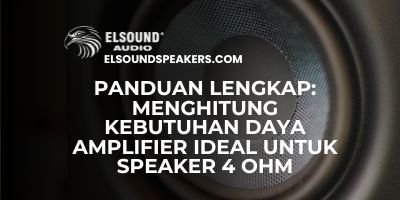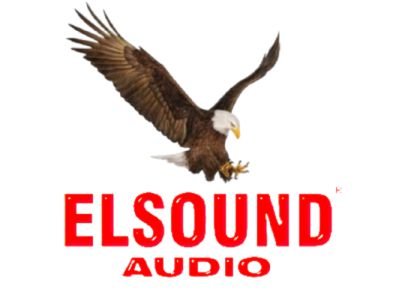
In the world of audio, the balance between amplifier and speakers is key to achieving the best sound quality. Many people buy speakers and amplifiers separately without taking into account their power and impedance match - the result is not optimal sound, and can even damage equipment.
This article will be a complete and practical guide to help you calculate the ideal amplifier power requirement for 4 Ohm speakers.
We will also discuss examples of its application to various types of speakers such as Cheap 6 Inch Subwoofer Speakers, Best 8 Inch Subwoofer Speakers, to Active Subwoofer Speakers.
Read to the end - because a small error in calculation can mean a big difference between perfect sound and a system that breaks down quickly.
Why Amplifier Impedance and Power Must Be Balanced
Before getting into the formulas and calculations, let's first understand the basic concepts.
What is Impedance (Ohms)?
Impedance is the electrical resistance that the speaker has to the current from the amplifier.
The value is measured in Ohms (Ω) - and this number determines how much current flows.
Generally, speakers fall into two main categories:
- 4 Ohm Speaker
- 8 Ohm Speaker
4 Ohm speakers tend to draw more current than 8 Ohm speakers. This means that the amplifier has to work harder. If the amplifier is not powerful enough, the result could be distortion or even component damage.
Why are 4 Ohm Speakers Popular?
Many products like the Best 6 Inch Subwoofer Speaker or the Good 8 Inch Subwoofer Speaker use 4 Ohm impedance because:
- It's easier to put out big power
- Suitable for car and home theater systems
- Able to produce deeper bass with low power
However, without a suitable amplifier, the best potential of a 4 Ohm speaker will not come out fully.
How to Calculate Ideal Amplifier Power for 4 Ohm Speakers
Now, we get to the meat of the discussion: how to calculate the amplifier's power requirements to balance with your 4 Ohm speaker specifications.
Step 1: Know your Speaker Specifications
Look on the back or manual of your speaker. It usually says:
Impedance (example: 4 Ohms)
Power Handling / RMS (e.g. 100 Watt RMS)
Peak Power (e.g. 200 Watt Max)
For example, let's say you have:
8 Inch 500 Watt Subwoofer Speaker
Impedance: 4 Ohms
Step 2: Use the Calculation Formula
The power requirement of the amplifier can be calculated using a simple formula:
> Ideal amplifier power = Speaker RMS power × 1.5 to 2 times
Why?
Because amplifiers with more headroom will:
- Avoid distortion when volume is high
- Maintain the stability of electric current
- Gives the speaker room to breathe
So if your speaker has 100 Watts RMS at 4 Ohms, then:
Ideal amplifier = 150-200 Watts RMS per channel at 4 Ohms.
For a 500 Watt 8 Inch Subwoofer Speaker, you should ideally use a 700-800 Watt RMS amplifier to keep the bass strong and not clipping quickly.
Step 3: Note the Amplifier Output Impedance
Make sure your amplifier is capable of operating at a 4 Ohm load.
Some amplifiers are only stable at 8 Ohms - using with 4 Ohm speakers can make the amplifier heat up quickly and even break.
Observe the writing on the back of the amplifier:
"Power Output: 150W @ 4Ω / 100W @ 8Ω"
If so, then the amplifier is compatible for your 4 Ohm speaker system.
Professional Tips for Determining Amplifier Power
Here are some handy guidelines to help you choose safely and appropriately.
Use a Safe Power Ratio
For Cheap 6 Inch Subwoofer Speakers or Good 6 Inch Subwoofer Speakers, choose an amplifier with 1.5x RMS power.
For the Best 8 Inch Subwoofer Speaker or 8 Inch 500 Watt Subwoofer Speaker, use a 2x RMS amplifier for maximum performance without distortion.
Example:
Speaker 150W RMS → Amplifier 225-300W RMS.
Speaker 500W RMS → Amplifier 750-1000W RMS.
Don't Just Stick to "Big Watts"
Many people have the misconception that the bigger the wattage, the better.
In fact, the quality of power (RMS) is more important than the big number of "peak power".
A stable 200 Watt RMS amplifier at 4 Ohms can beat an unstable 400 Watt amplifier at low frequencies.
Customize with Speaker Type
Different types of speakers have different power requirements:
- Active Subwoofer speakers already have built-in amplifiers, so there is no need for external additions.
- 8 Inch Subwoofer Speaker For Car usually requires a class D car amplifier with high efficiency.
- The Best 6 Inch Subwoofer Speaker is better matched with a class AB amplifier for fine sound details.
Use a Stable Power Supply
Amplifiers with large power require a stable power supply.
If the voltage in your home drops frequently, use a stabilizer or UPS to maintain the quality of the audio output.
Real World Application
Let's look at some examples of using amplifiers and speakers to make it easier to understand.
Example 1: Home Studio System
You have a Best 6 Inch Subwoofer Speaker rated at 100 Watts RMS (4 Ohms).
Use an amplifier:
150-200 Watts RMS @ 4 Ohms
As a result, the sound remains clear, the bass is dense, and there is no clipping even at high volumes.
Example 2: Car Audio System
Your car is equipped with an 8 Inch Subwoofer Speaker For Car, power 300 Watt RMS (4 Ohm).
Then, use a class D monoblock amplifier:
450-600 Watts RMS @ 4 Ohms
This type of amplifier is efficient, does not heat up, and is suitable for limited car space.
Example 3: Mini Stage System
You are using a 500 Watt 8 Inch Subwoofer Speaker and some Active Subwoofer Speakers.
Make sure that the external amplifier has enough headroom:
750-1000 Watts RMS per channel @ 4 Ohms
Add an active crossover so that the low and high signals are well separated.
The Difference between 4 Ohm and 8 Ohm Speakers: Which is Better?
Both have their own advantages.
Factor 4 Ohm Speaker
Electric Current Bigger
Power Efficiency More wasteful
Bass Power More robust and responsive
Suitable for Car, home theater
8 Ohm Speaker Factor
Electric Current Smaller
Power Efficiency More efficient
Bass Power Smoother
Suitable for Studio, PA system
So, if you want a system with aggressive bass and big power, go for 4 Ohm speakers like:
Cheap 6 Inch Subwoofer Speaker
Cheap 8 Inch Subwoofer Speaker
However, if you want a flat and precise sound for mixing, an 8 Ohm speaker would be ideal.
—
Common Mistakes to Avoid
Many users of 4 Ohm speakers experience problems not due to product quality, but due to errors in power calculation.
Here are some fatal mistakes that often occur:
- Amplifier is too small (underpower)
The speaker will lack power, produce severe distortion, and even damage the coil.
- Amplifier is too big (overpower)
Can burn the speaker's voice coil, especially on Cheap 6 Inch Subwoofer Speakers.
- Not paying attention to the output impedance of the amplifier
Connecting 4 Ohms to an amplifier that only stabilizes at 8 Ohms can overheat the transistors.
- Installing multiple speakers without correct parallel/series calculation
The total impedance can drop drastically and overload the amplifier.
—
A Practical Guide for Beginners
To avoid making the wrong choice, use this simple guide:
Speaker Type RMS Power Impedance Ideal Amplifier Power
- Cheap 6 Inch Subwoofer Speaker 80 Watts 4 Ohm 120-160 Watts
- Best 6 Inch Subwoofer Speaker 120 Watts 4 Ohm 180-240 Watts
- Cheap 8 Inch Subwoofer Speaker 200 Watts 4 Ohm 300-400 Watts
- 8 Inch 500 Watt Subwoofer Speaker 500 Watts 4 Ohm 750-1000 Watts
- Active Subwoofer Speaker Built-in 4 Ohm No need for additional amplifiers
With this guide, you can customize your amplifier according to the capacity and character of your speakers without risking damage.
—
Why Elsound Speaker & Audio is Worth Choosing
When it comes to audio systems, choosing a trusted brand is everything.
This is where Elsound Speaker & Audio lives up to its reputation - not just selling products, but offering complete audio solutions for all needs.
Elsound provides:
- Cheap 6 Inch Subwoofer Speakers and Best 6 Inch Subwoofer Speakers for home setup.
- Best 8 Inch Subwoofer Speakers and Good 8 Inch Subwoofer Speakers for professional systems.
- An Active Subwoofer Speaker that comes with a high-quality internal amplifier.
Direct technical consulting support from an experienced team.
With high-quality products and an official warranty, Elsound ensures every customer gets clean, powerful and long-lasting sound.
🎧 Call now at elsoundspeakers.com - 0851-7988-9353
Get recommendations on the most suitable amplifiers and speakers for your system before stocks run out!
Also read the following articles
Comparison of Class D vs. Class AB Amplifiers for Studio Monitor Speakers - Elsound Audio
Conclusion
Determining the ideal amplifier power for 4 Ohm speakers is not just a matter of numbers, but a matter of technical balance and sound performance.
One wrong move can cause costly damage, while one correct calculation can result in an amazing sound.
Remember the principle:
Use an amplifier 1.5-2 times the RMS power of the speaker
Make sure the amplifier is stable at 4 Ohm impedance
Choose a trusted brand like Elsound for maximum results
Whether you're using a Good 6 Inch Subwoofer Speaker for a small room, or a 500 Watt 8 Inch Subwoofer Speaker for a large system, everything will work perfectly when your amplifier is calculated correctly.
Don't wait until your speakers are damaged due to power miscalculations.
Contact Elsound Speaker & Audio today at elsoundspeakers.com - 0851-7988-9353, and make sure your audio system works in the perfect balance between power and sound clarity.
Read the rest of the article below:
https://elsoundspeakers.com/category/artikel/




